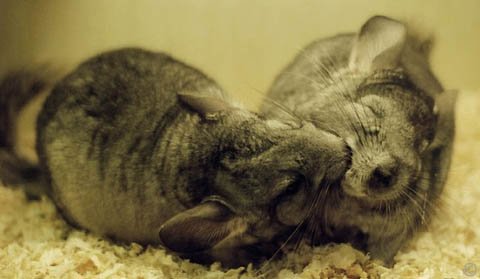 There are two reasons why you will choose to introduce chinchillas together:
There are two reasons why you will choose to introduce chinchillas together:
- To breed together two chinchillas and produce offspring
- To provide company for a lone chinchilla
Chinchillas love to interact and communicate with others, living in the wild in colonies of up to 100 other chinchillas, it is therefore hardly surprising to know in captivity chinchillas enjoy the company of a mate.
A chinchilla living in a pair is generally happier, more stimulated and less stressed than lone chinchillas but it must also be remember that unless chinchillas are together from birth (and even then they can still fight spontaneously) they will need to be introduced slowly and more so if one has been living on its own for a period of time.
Even if you are introducing chinchillas for breeding purposes, the procedure of the initial introductions must be followed correctly and never house chinchillas of the opposite sex under 9 months old together as breeding will occur causing potential birthing complications to the under developed/immature female.
Remember: There is no guarantee that introducing chinchillas will be successful as all chinchillas are individual. The issue should never be rushed if you are to house happy chinchillas together.
You can increase the success rate of introducing chinchillas by making sure you follow the correct procedure as shown below and NEVER just put a new chinchilla into the cage of another chinchilla without properly introducing them first. The latter will cause the current chinchilla to become protective of its environment and most likely immediately attack the intruder (wouldn't you if someone just walked in to your home?).
The Correct Way To Introduce Chinchillas...
To introduce chinchillas correctly, place both chinchillas in a separate cage and keep the cages side-by-side about 2" apart so the cages do not touch and the chins cannot bite one another through the wires but instead, get used to one another through sight and smell first.
You may notice the chins run and bounce off the wire wall nearest to the other chin's cage or spit and urinate (if it is the female) at one another - this is natural and only the chinchilla marking its territory and annoyed that another chinchilla is in its vicinity. Over the next few days the chinchillas will calm down to a point where you will witness them sitting calmly at the end of the cage where the other one habitats.
Observe the behavior of both chinchillas and if you see any signs of continued aggression, move the cages further apart and keep repeating the process until the chins are calm and happy to be near one another as suggested above.
When both chinchillas are happy to be near one another, it is at this point, they can have physical contact with one another and proper introductions can commence.
 WARNING - Females are generally the most dominant and can potentially kill their male companion if introductions are not done properly. If a female rejects her mate she will show her disinterest/annoyance by standing up on her hind legs and spraying urine at him before attacking if he doesn't get the initial message. You must therefore provide complete supervision during initial introductions.
WARNING - Females are generally the most dominant and can potentially kill their male companion if introductions are not done properly. If a female rejects her mate she will show her disinterest/annoyance by standing up on her hind legs and spraying urine at him before attacking if he doesn't get the initial message. You must therefore provide complete supervision during initial introductions.
The best way to introduce chinchillas is to allow them freedom in a neutral territory such as a hallway. Place a sand bath in the middle of the room and allow the chinchillas some 'out of cage' activity at the same time. Fully observe their interactions - most of the time, chinchillas usually start off by investigating their new environment and seem uninterested in meeting until they bump into one another. They will then either sniff, nibble and communicate with the other or begin fighting.
Make sure there are plenty of 'hide - away' places such as tubes and cardboard boxes so the chins can hide if they want to and only return them to their separate cages if fighting commences. Should this be the case, witness both chinchillas behavior on the return to their individual cages and try introductions again when they express calmness in the others company (usually by the following night).
When the chinchillas seem comfortable after being introduced and content to be near one another whilst on the open floor, choose which cage they are to live in - if possible it is best to house them in a new cage that neither has claimed territory. If you will be using an existing cage choose the cage the male lives in as the female can be too territorial of her own cage and fighting may occur if using her cage for cohabitation.
 Place plenty of toys, gnawing material and 'hide-a-ways' within the cage (to encourage the chins to take focus off one another) and allow both chins to enter the cage at the same time.
Place plenty of toys, gnawing material and 'hide-a-ways' within the cage (to encourage the chins to take focus off one another) and allow both chins to enter the cage at the same time.
Observe the chinchillas at all times during the cage introduction stage - do not worry if you hear a few noises or there is a small scuffle, this is just them trying to sort out living arrangements and what they like or don't like - just keep watching!
Do not separate the chinchillas unless you see them use their teeth or blood is drawn. If this happens you will need to immediately separate the chinchillas into separate cages and begin the process from the beginning again.
Chinchillas need time to get used to one another during introductions and in a cage with limited space it is imperative they get on! It is a good idea to also place a dust bath within the cage, which will help relax the chinchillas as they jump into one another sand neutralizing individual scent.
After a couple of hours and only when you see the chinchillas sitting next to one another, nuzzling and grooming can you leave them and know so far the introduction stage has gone well!
It is recommended that during the first few nights of the initial introduction days, you maintain a regular check on how the chinchillas are interacting. Generally as soon as chinchillas are cuddled up together, they have accepted one another and are more than happy to live together for life.
Tips For Easy Chinchilla Introductions and Happy Co-Habitating Chins:
- Make sure the initial introductions are done slowly and correctly.
- Introduce chinchillas in the mornings when they are more than likely to sleep than be constantly awake and active during the night.
- Ensure the cage is large enough to accommodate two chinchillas and always make sure there are plenty of hiding places for a chinchilla to go, especially during mating season and initial introductions.
- Allow both chinchillas plenty of exercise out of their cage environment on a daily basis.
- If you want to avoid introducing chinchillas but would like a chinchilla pair, consider buying two young sisters, two brothers, mother and daughter or father and son. The only problem that can arise is when housing male chinchillas together - if both are sexually mature and you bring a female into the vicinity then serious complications and fatal fighting will occur.

WARNING - Once chinchillas have taken to living with one another, it is not recommended that they are separated at any point unless certain conditions occur (for example male attacks a young offspring). This is also the case if either of the chinchillas needs a veterinary visit.
Co habitating chinchillas will attack one another on return if they are separated during a period of time. This is due to the absent chinchilla returning to the cage environment smelling different (for example of the veterinary surgery) rather than the scent of the chin who originally left. The existing chinchilla will then think the same chinchilla is an intruder and will attack without mercy.
If either of the chinchillas need to visit a veterinary surgeon, take both chinchillas in the same carrier and ask for the chins to be kept together (apart from when examining or operating). This will help keep the chinchillas of the same scent and will not cause any problems when returning them to the cage environment.
Another good reason to keep chinchillas together on veterinary visits is usually a veterinary consultation happens when a chinchilla is unwell. The accompanying chinchilla can nuzzle and nurture a poorly chinchilla and will also help alleviate stress for the sick chin.
Further Reading Relating To Introducing Chinchillas:
An Essential Guide To Owning A Chinchilla, Breeding Chinchillas, Chinchilla Cage, Male Castration, Toys & Accessories.


 There are two reasons why you will choose to introduce chinchillas together:
There are two reasons why you will choose to introduce chinchillas together: WARNING - Females are generally the most dominant and can potentially kill their male companion if introductions are not done properly. If a female rejects her mate she will show her disinterest/annoyance by standing up on her hind legs and spraying urine at him before attacking if he doesn't get the initial message. You must therefore provide complete supervision during initial introductions.
WARNING - Females are generally the most dominant and can potentially kill their male companion if introductions are not done properly. If a female rejects her mate she will show her disinterest/annoyance by standing up on her hind legs and spraying urine at him before attacking if he doesn't get the initial message. You must therefore provide complete supervision during initial introductions. Place plenty of toys, gnawing material and 'hide-a-ways' within the cage (to encourage the chins to take focus off one another) and allow both chins to enter the cage at the same time.
Place plenty of toys, gnawing material and 'hide-a-ways' within the cage (to encourage the chins to take focus off one another) and allow both chins to enter the cage at the same time.